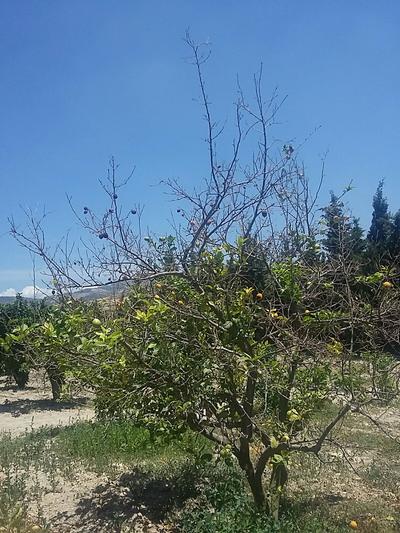Mal Secco
Phoma tracheiphila
Fungus
In a Nutshell
- Shoot and interveinal leaf chlorosis followed by dieback of twigs in spring.
- Sprouts and suckers grow at base of infected branches and rootstock respectively.
- Gum production in internal vessels, showing as pink or orange discoloration.
Can also be found in
Symptoms
The symptoms may appear first on individual branches or sectors, and if not amended, may extend to the rest of the tree, that can then die. The first symptoms appear in spring as shoot and interveinal leaf chlorosis followed by a dieback of twigs and branches. Raised black points within lead- or ash-gray areas of withered twigs indicate spore masses. The growth of sprouts from the base of the affected branches and suckers from the rootstock are a very common response of the host to the disease. When the wood of infected twigs, branches or trunks is cut or stripped of bark, characteristic salmon-pink or orange-red discoloration of the wood may be seen. This internal symptom is associated with gum production within the vessels.
Recommendations

Organic Control
Fungicides based on copper can be used against the pathogen. The protectant copper fungicides will need to be applied repeatedly to the canopy during the period of greatest susceptibility from autumn to spring. Pseudomonas bacteria inhabiting the rhizosphere, for example Pseudomonas fluorescens and Pseudomonas putida were also shown to inhibit the growth of Phoma tracheiphila in culture.

Chemical Control
Always consider an integrated approach with preventive measures together with biological treatments if available. Products based on ziram (zinc dimethyldithiocarbamate) are very effective in the control of Phoma tracheiphila. Systemic products such as carboxin and benzimidazole are also effective as preventive treatments. A mixture of a protectant and a systemic fungicide is recommended, particularly after weather conditions such as a freeze, hailstorm, or strong winds that cause wounds to the tree.
What caused it?
The fungus enters through wounds in leaves, branches and roots. The spores are thought to be waterborne. The fungus can survive within infected twigs or branches in the soil for more than four months. This can be an important source of inoculum for several weeks. Spores are dispersed from the trees and debris by rain splashes or overhead irrigation. Some may become airborne. The fungus usually spreads only over a short distance, between 15 and 20 m from an initial source, although the prevailing wind direction may increase the distance. The range of temperature at which infection will occur is between 14 and 28°C, with an optimum at 20-25 °C.
Preventive Measures
- Buy seeds from certified sources.
- Plant resistant varieties, if available in the area.
- Do not use plants from nurseries in areas where the disease is common.
- Prune trees as soon as the first symptoms appear.
- Monitor the orchard regularly and destroy infected plant parts immediately, including uprooted tree stumps.
- Injury during cultural practices must be avoided.



